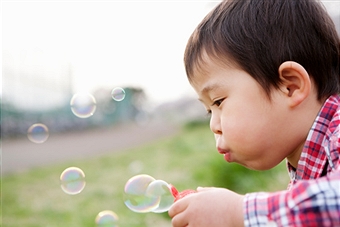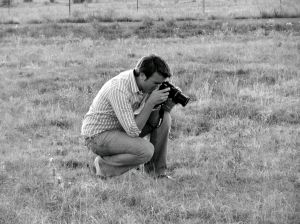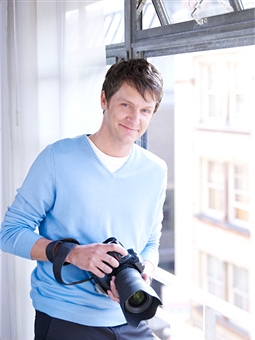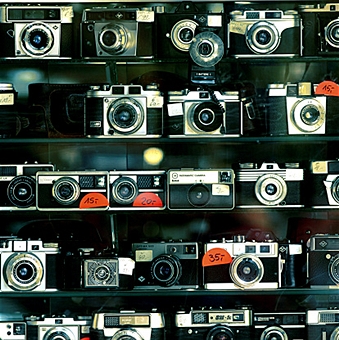Monday, June 24, 2013
Tips in Taking Great Candid Photos That Capture Life’s Perfect Moments
Candid photos are stolen shot photos that focus on what your subject is doing naturally and not on what the subject should be doing. These photos look really great as they look less cheesy and more natural. But how can one capture the best of life’s most spontaneous moments?
If you really want to learn or improve your skills in taking candid photos, then you can check out and use these tips to successfully take candid pictures.
 - Always bring your camera with you wherever you go. A good quality point-and-shoot camera will be quite handy as it is going to be easy to bring it with you because of its small size. If you always have your camera with you, you have more chances of capturing those spontaneous moments in life. At the same time, your family and friends are going to get used of seeing you with your camera so when they see you take their pictures they wouldn’t mind you at all and you’ll get to capture them in their unguarded moments. With your camera with you, you should be very observant of what is happening around you. You should literally point and then shoot whenever there is an opportunity for you to take candid photos in any situation.
- Always bring your camera with you wherever you go. A good quality point-and-shoot camera will be quite handy as it is going to be easy to bring it with you because of its small size. If you always have your camera with you, you have more chances of capturing those spontaneous moments in life. At the same time, your family and friends are going to get used of seeing you with your camera so when they see you take their pictures they wouldn’t mind you at all and you’ll get to capture them in their unguarded moments. With your camera with you, you should be very observant of what is happening around you. You should literally point and then shoot whenever there is an opportunity for you to take candid photos in any situation.
- Avoid using your flash if possible. Sometimes a perfect moment gets spoiled when a flash goes off unexpectedly. If there’s not enough light you may open your camera’s aperture and increase its ISO. An ISO of 400 can help you capture quality candid images. If you have no choice but use a flash, remember not to use the red eye feature as it can be distracting as it creates multiple flashes before you take the picture.
- Learn to blend with the surroundings so as not to get obvious while taking a shot. You can hide your camera or place it by your waist instead of holding it near your eye when shooting. This trick allows you to take photos at a different angle as well.
- Use the telephoto lens of your camera when shooting at a good distance. Make sure you are not seen so your subject will act naturally as you take some candid shots. You may use the maximum zoom capacity of your camera if needed.
- Take pictures of people doing things like when they’re having a good laugh or when they’re busy doing something and aren’t focused on you taking their photos. This will make your candid photos more spontaneous and interesting. And if you wish to highlight the emotion of your subject’s face, then you may also convert the photo into a black and white image. Black and white images show more emotion and are more dramatic in effect.
- In order to avoid conflict and invasion of a person’s right to privacy, it will be safe to ask for your subject’s permission if appropriate.
- To increase your chances of taking a great shot, take advantage of your camera’s continuous shooting mode and shoot as many pictures as you can. Also, to create an emotion or story of a certain situation or occasion, try to take pictures of more than one person in one frame.
If you want to capture a great candid photo then you should experiment as often as you can and check out other people’s work for
The best way to capture a great candid picture is to experiment more often. Explore everything, try all angles, and don’t forget to see other’s work for some inspiration.
Monday, May 20, 2013
Pet Photography Basics And Tips
Pet photography is actually an art that requires knowledge in capturing your pets with just the right expression. You know that taking pictures of your pet is not an easy thing to do. They definitely can’t hold a pose for you to take their picture. So, if you wish to capture a treasured photo of your family pet then there are a few things you need to know that will help you capture great photos of your pets.
 1) Before you do anything else, read and study your manual first. Nothing is more frustrating than trying to figure out the best settings as your dog does a triple flip off the diving board.
1) Before you do anything else, read and study your manual first. Nothing is more frustrating than trying to figure out the best settings as your dog does a triple flip off the diving board.
2) If you want to have a crisp, clean, with no blur images, set your shutter speed to at least 1/250 of a second or faster. If you’re using a point and shoot, just set the dial on the action icon.
3) Watch and wait for the right pose or expression that represents the character of your pet. This might take some time, so relax and be patient. Sometimes you can get lucky if it happens very quickly but there are also times when you’d feel you will never get the shot. Hence, always keep in mind that capturing stunning photos of your pets requires a lot of patience.
4) Shoot often and continuously so that your pet will get used to the sound of the camera. This will also allow you to capture candid shots in between formal poses. You might be surprised at some of the images you captured when you review them.
5) The character and soul of your pet can be more dramatically captured if you get down to their eye level. So unless your pet is a horse, you would need to get down low enough to photograph at eye level. If you are taking a picture of a cat or a puppy, get flat on the floor and use your elbows to prop your camera up to your eye. You may experiment with different angles to come up with exceptional portrait. You can try shooting down from above by standing on a chair or anything solid. Just remember, the eyes should be in perfect focus to produce effective and unique photos.
6) You can use props like battery-operated toys, a whistle, or a bright cloth flapping in the wind to capture dynamic expressions. But be ready and be quick as props only work until your pet gets bored.
7) Poor backgrounds could ruin pet photographs. Move your pet to another location if the background shows a garbage truck, an ugly fence, or a parking lot. You can also crop out background clutter that you can’t eliminate by moving in close to your pet to give your viewer a sense of being right there.
8) Avoid using the digital camera’s integrated flash. Such light changes the shades and hues of your pet and flattens all the details on the image. It could also cause red eye to your pet photo, creating that satanic and possessed appearance.
9) Don’t forget to use the rules of good composition in photography. Aside from getting that interesting shot or perfect expression, make sure that you are using your thirds, the background complements the subject and that your background is uncluttered.
There are actually quite a handful of things to remember in such a short span of time when you’re working with animals. So, I agree when they say taking pet portraits is quite challenging but it’s also extremely rewarding to say the least.
Thursday, May 9, 2013
How to Look Good In Photos
Everybody wants to look their best, if not good, in photos. Well, here are some tips for looking good in photographs:
 1. A genuine and honest smile is the simplest and the best way to look great in a photo. Whether you’re gathering with friends for a quick snapshot or sitting for a formal portrait, the secret is to be relaxed. Think of happy thoughts and trust the photographer to make you look good. Try to find a good reason to laugh. Remember, a genuine smile comes with a laugh that makes your eyes sparkle.
1. A genuine and honest smile is the simplest and the best way to look great in a photo. Whether you’re gathering with friends for a quick snapshot or sitting for a formal portrait, the secret is to be relaxed. Think of happy thoughts and trust the photographer to make you look good. Try to find a good reason to laugh. Remember, a genuine smile comes with a laugh that makes your eyes sparkle.
You can also practice your smile. Spend some time in front of the mirror. Find the smile that you love and try to remember how it feels so you can mimic the smile every time a camera appears.
2. Make sure you’re not a victim of any harsh, direct light. Direct light, especially from the sun, will force you into features and positions such as squinting which in pictures swallows up your smile or dipping your head which will give you a second chin. To avoid direct light, try to reposition yourself so that neither glare nor squint can sabotage your next photo.
3. Do not look straight at the camera. Learn to have your photo taken by looking slightly above the lens or by showing your good side (it’s usually the side where your hair parts). To create a more dynamic angle and to elongate your neck, try to lower your front shoulder slightly. Also, stick out your chin a little bit to prevent double chin.
4. Blink your eyes right before the camera clicks. This is to avoid getting caught in a blink or with your eyelids sagging like you’re beat. Blink encourages your eyes to be alert and communicative when the camera snaps the picture.
Tuesday, April 30, 2013
Taking Great Pictures Of Your Baby
Everyone loves looking at pictures of babies, right? So, if you’ve got a little tot in the house, it’s time for you to get your camera ready and start taking and sharing those cute baby pictures now. That’s what proud parents normally do. However, being able to take great pictures of your baby is such a big challenge. Well, here are some tips on how to take better shots of your baby:
 1. Always be ready with your camera. You’ll never know as to when your baby will do something for the first time or do something entertaining. Hence, it is important to have your camera nearby and ready to go. This means making sure you have enough battery life in your camera at all times and also making sure there is enough room in your memory stick or card.
1. Always be ready with your camera. You’ll never know as to when your baby will do something for the first time or do something entertaining. Hence, it is important to have your camera nearby and ready to go. This means making sure you have enough battery life in your camera at all times and also making sure there is enough room in your memory stick or card.
2. Do not waste your time trying to take posed shots and take candid shots instead. Candid shots are more relaxed and natural compared with posed shots. Besides, some of the sweetest pictures of babies are actually candid shots. If your camera has a good zoom lens, you can always take great candid shots of your baby from a distance without him knowing you are there.
3. Take as many shots of your baby doing the same thing as you can. A professional or an amateur photographer knows that not all pictures will turn out well, especially if you use a high-speed camera. This way you’ll have better chances of capturing the right moment and have more options to choose which pictures are better from the others.
4. Most digital cameras feature black and white and sepia settings, so take advantage of this. When you take photos of your baby in black and white, you need not worry about what your baby is wearing since everything will look good and look more natural.
5. Don’t forget to print those digital pictures. Your baby will grow and change too fast so make it a point to print and share your photos as often as you could. Also, make sure to have a back up of these pictures on a disk on a regular basis. You wouldn’t want to lose all those precious moments you’ll never be seeing again.
Monday, April 29, 2013
Ways to Make That Digital Camera Battery Last Longer
Digital cameras have plenty of features that it then becomes difficult for us to make its battery last longer. Today, I’m going to share with you the things you can do to improve the length of time that your batteries stay charged.
There are three biggest sources of power drain to your digital camera battery: the LCD screen, the flash, and the zoom. The LCD screen uses up the most power. So, turn this feature off unless you really feel the need to use it. You can use the camera’s viewfinder instead to conserve power. The flash is another big power drainer. Use natural lighting to take your photos and use only the camera flash when you absolutely need it. Now, constantly using your zoom will likewise drain your battery. Find a setting you like and stick with it as much as possible because it takes up more power when you zoom in and out than when you keep your zoom at a steady place.
Of course there are other things you can do to make your digital camera battery last longer.
- Switch power saving mode on or switch off your camera when you’re not using it.
- During cold weather, keep your camera and batteries warm inside your jacket since the cold drains batteries very quickly.
- Store batteries away from sunlight and other heat sources.
- Avoid unnecessary reviewing of taken images and wait until the pictures are downloaded to your computer.
If you follow these tips and use it as a precaution then perhaps you won’t need to buy more or recharge your battery as often as you should.
Thursday, April 11, 2013
Basic And Important Features of Digital Cameras
Digital cameras, unlike the conventional cameras, take pictures without the use of films. It does not rely on mechanical and chemical processes. It has a built in computer and saves the images it captures in digital form.
When choosing and buying the best digital camera, there are some key features you have to take into account. Below are some of the features that will help you decide in buying that digital camera.
 Lens – The digital zoom of the camera will let you take the pixels from the image sensor and integrate them to make an image. So choose a camera that has a better digital zoom.
Lens – The digital zoom of the camera will let you take the pixels from the image sensor and integrate them to make an image. So choose a camera that has a better digital zoom.
Image quality – The higher the resolution of the camera, the more you’ll be able to enlarge the picture minus the out-of-focus or grainy effect you like to avoid.
Options – Choose one that has options that caters to your lifestyle so you won’t complain how you never get the right pictures and can boast to your friends how good a photographer you are.
Power – Always go for rechargeable batteries, they come in handy and you’ll just waste a lot of money on disposable ones.
Memory – Be sure that you’ve got enough memory in your camera if you’re a photo freak and takes pictures of just about anything.
Computer Interface – Make sure your digital camera is compatible with your laptop, PC or your local picture printer software.
Physical – Choose a handy and portable digital camera and not the heavy and bulky ones if you’re going to bring it with you everywhere.
These are just some of the basic elements you need to look for in a digital camera if you intend to buy one.
Saturday, April 6, 2013
How to Earn Extra Money With Your Digicam
Do you wish to bring in extra income into your household but don’t have the luxury of time to devote in a full-time job or business? If you have a digital camera then all you need to do is follow these tips and you can make money during your spare time using your camera.
 Pet Photos - Most of the time pet owners don’t like to take photos with their pet all by themselves. You can be the solution to that. By taking the picture for them, you can charge them for your service and time. Likewise, you may offer the photo as a print or in its digital form which you can mail to them later on. You can do the prints using your own photo printer or through a photo processing service.
Pet Photos - Most of the time pet owners don’t like to take photos with their pet all by themselves. You can be the solution to that. By taking the picture for them, you can charge them for your service and time. Likewise, you may offer the photo as a print or in its digital form which you can mail to them later on. You can do the prints using your own photo printer or through a photo processing service.
Graduations - Be it preschool, high school, or college graduations, these are significant moments in every person’s life that provides opportunities for you to capture. You’ll even have greater opportunity if the family members of the graduate don’t have a good camera and are not seated in a good location as you are.
Photo Novelty Items - You can take pictures of people who like to see pictures of themselves or their loved ones printed on key chains, t-shirts, coffee mugs, and other items.
Holiday Postcards – You may also offer your services to families who want their picture taken and printed on a postcard that they could mail to their relatives and friends.
Newborn Photo Service – You may advertise and provide on-call services to the parents of newborn babies. You can take snapshots of the family before they leave the hospital or right after they get home. This way both the child and the parents can be in the pictures together.
Tuesday, April 2, 2013
How To Take Better Pictures Using Your Digital Camera
Cameras make picture taking a lot easier nowadays. But would you like to make those photos go from acceptable to great? Here are some tips to help you improve your craft.
 1. Always be aware of the background. A passing vehicle could draw attention from your subject. Likewise, you wouldn’t want to find trees growing out of people’s heads. Sometimes moving your subject just a few steps to either side can make all the difference.
1. Always be aware of the background. A passing vehicle could draw attention from your subject. Likewise, you wouldn’t want to find trees growing out of people’s heads. Sometimes moving your subject just a few steps to either side can make all the difference.
2. Use available light. If your digital camera has an option to turn the flash off and you think there’s enough light outside to read a book then turn your flash off and use the available light. Camera flashes could be too harsh for human skin and make all of us look pale. Indoors and where there isn’t enough daylight, you should place your subject near the window and use your fill flash feature.
3. Aim your camera slightly below the person’s face. Don’t shoot just face on to the person. Try to shoot a little to the side, a three quarter view, so that you see more of their face. This technique will slim your subject.
4. Remember your focus and get closer to your subject. Fill the frame with your subject and there will be no doubt as to what your picture is saying.
5. Never put your subject dead center. Put it just slightly off center, not a lot. If you’re shooting groups of people, find the imaginary center line of your group and put that line just a bit off center in your view through your screen or lens.
These tips won’t turn you into an award-winning photographer today but these will definitely help you come up with better and more powerful photographs which others will comment on for years to come.
Tuesday, March 26, 2013
Knowing The History Of Photography
While we moved away from film and moved into the digital age, it is just appropriate for us to find out where modern photography came from. Do you know that lighting and other photography techniques started in the 1820’s? Daguerre and Niepce were actually the first inventors of modern photography and they made use of a chemical component from chalk and silver that darkens when exposed to light. This kind of technology used a glass negative to cement the picture.
 Next to this were the manual cameras with film. The negative or film captured the image on a roll and were developed in a dark room to avoid over exposure. With manual cameras, you had to understand aperture, white balance, shutter speed, and metering to get the best picture possible.
Next to this were the manual cameras with film. The negative or film captured the image on a roll and were developed in a dark room to avoid over exposure. With manual cameras, you had to understand aperture, white balance, shutter speed, and metering to get the best picture possible.
Aperture is determined by F-stops or the amount of light the lens will let in. Focusing and depth of field are also important in setting the aperture of your camera. To avoid over exposure and blurriness, you need to know what numbers allow more light to enter the lens and the converse. On the other hand, shutter speed is the amount of time a lens is open for the photo. Notice that in a dark room your camera without flash takes a while to imprint the image on a negative. This happens when the light is dim and the shutter needs to adjust. The lack of light causes a need to expose the film longer to obtain the photos while more light makes the shutter move at a faster speed.
Now, from the manual cameras we move on to automatic. This camera is lighter and at the same time its aperture and shutter speed is already programmed in the settings. You just need to choose the right settings and hold the button down to focus. However, a number of automatic cameras still have manual options being used by people who treat photography as an artistic profession.
Digital camera is the new age in photography. It allows us to view the picture we take without the use of film and negatives. It also allows us to send the pictures to our friends and to print them using our home printers. In this age, everyone can take pictures and not just a few who are skilled in taking the perfect shot.
In spite of this development, the need for professional photographers remains in demand. Light sensitivity remains important with digital cameras. One really has to learn the techniques in taking pictures when using available light, be it natural or artificial. Hence, it is important that we know past photography techniques for us to obtain quality photographs using our digital cameras.
Wednesday, March 20, 2013
Still Life Photography: Back To The Basics
Staring at the new resin floor we had installed recently, I decided to take photos of it. Still-life photography is one of the first lessons in any photography class and can be more difficult than you could imagine. It is easier as compared to landscape, children and pet photography but it is actually a challenge to make still-life objects interesting with your camera.
Yes, you can actually be the photographer you’ve always wanted to be and I’m going to help you become that photographer. This could be the start of one of the most exciting, fun and rewarding things you’ll ever do. However, you would need a good balance between subject matter, angles, and lighting to have a good still-life photo. Below are the things you should keep in mind to be able to accomplish that.
 1. Find inspiration from professional still-life images. Choose the ones that catch your eye and appeal to you somehow. Pay attention to subject matter, shadow and angles that the photographer used. This could help inspire your own photography.
1. Find inspiration from professional still-life images. Choose the ones that catch your eye and appeal to you somehow. Pay attention to subject matter, shadow and angles that the photographer used. This could help inspire your own photography.
2. Choose your subject or the objects you’re going to shoot. Keep the picture simple and with less objects, possibly three. Gather a variety of objects to practice taking pictures such as fruits, vegetables, flowers, books and figurines. The types of subjects you choose will vary and depend on the style you are aiming for.
3. Arrange the subjects you’re going to shoot. You may place a smaller object leaning against a larger object. If your photo subjects are books, you may stack them on top of each other. Try different angles from which to photograph.
4. Choose a nice setting for your still-life photography. If you want to use a light box to create a soft, natural look, then you should use at least two lamps; one for the strongest amount of light and the other for filler. For natural light, you may place your subjects near an open window. Remember to pay attention to shadows from the outside or from the sun. You should also opt for backgrounds that are solid or plain colored, which will not detract from your still subject.
5. Practice taking pictures with different lenses, in different lighting, with a variety of shadows, backgrounds and angles. If you’re using natural light, take photos during various times of the day until you’re satisfied with the effect.
Besides, still life photography is an extremely rewarding business since magazines, websites, and catalogues all require product shots. There are many benefits to photography which are often underestimated. Hopefully with the basics I shared with you, you’ll be creative and start taking some shots yourself!
Wednesday, September 19, 2012
Welcome
Welcome to our photography blog where you will find all you need to know about cameras, photography basics, and professional photography. We’ll be sharing with you tips and everything you need to improve your skills in photography and become like a pro!